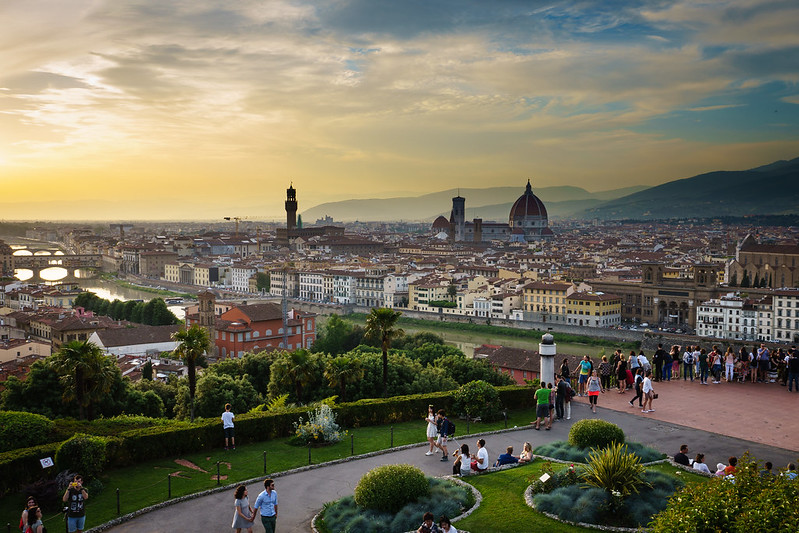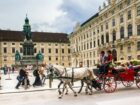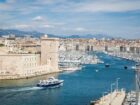If you’re trying to decide between Bologna and Florence for your short stay in Italy, you’ve come to the right place. In this post, I’ll highlight the main differences between these two great cities and help you decide which is better for you as a base location.
Florence and Bologna are both the capitals of their regions, Tuscany and Emilia-Romagna.
Though Florence and Bologna are comparable in size (700K vs 800K residents), they have very different vibes!
Florence is known worldwide for being the undisputed center of Italian Renaissance art and architecture. Its stunning historical sights can be explored for days. However, the city is always densely packed with tourists from all around the globe. Bologna is a quieter and more relaxed wealthy university city with a more authentic feel. It has many beautiful sights of its own, albeit not as spectacular as Florence. It’s also known for its great food and shopping.
Table of Contents
Bologna or Florence: what travelers say
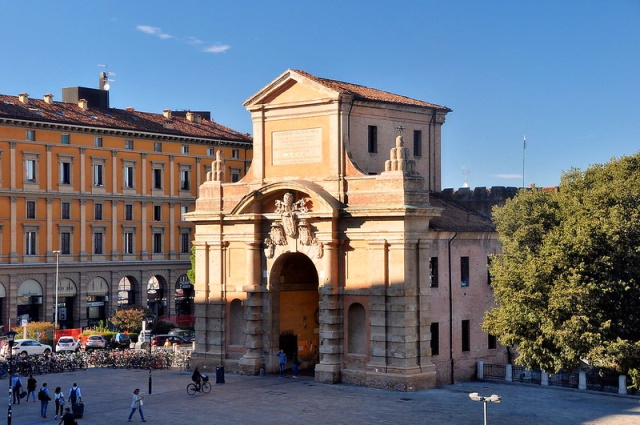
- Bologna is much less tourist overrun than Florence so the locals are friendlier to visitors. The city can also feel a bit more industrial in some parts but is nonetheless an interesting place to visit.
- Bologna gives you a more intimate and quieter experience with some nonetheless really good sights though not as spectacular as Florence. The latter, on the other hand, offers a stunning display of famous Italian Renaissance art and architecture works (Michelangelo, Da vinci, Titian, etc) that can easily fill a longer stay.
- Bologna is more of a provincial town but is well-known for its great food. It has excellent restaurants and pubs. While it also has beautiful art displays, It’s quieter and more easy-going than Florence, namely due to fewer crowds.
- Bologna is easy to walk around with a smaller center than Florence. It has a rich student life and alternative scene due to the university, the oldest in Europe.
- Bologna is a good option for a one-day or weekend stay. It has fewer sights than Florence and is easier to manage for a short stay, while still offering a charming ambiance. Florence has too much to see in such a short time.
- Some travelers would not want to go back to Florence but would happily return to Bologna due to the relaxing vibe, the amazing food, and the numerous attractions when walking around the city, including shops and markets, museums, and attractive porticos.
- Others prefer Florence because of its beauty and legendary Renaissance art sights, art exhibits and museums, art schools of painting etc, which are richer than in Bologna. They choose Florence in spite of the heavy tourist crowds.
- Bologna is great for young people because of the university atmosphere and musical culture, including jazz cafes and clubs, opera etc.
Bologna or Florence: access & transportation
Florence’s train station is within walking distance to the major sites, and only ten minutes away from the Duomo. Bologna’s station is outside of the city center and much too far to walk.
Traveling between Florence and Bologna takes only 37 minutes on the fast train; the slower train takes 90 minutes.
Bologna or Florence: vibe & people
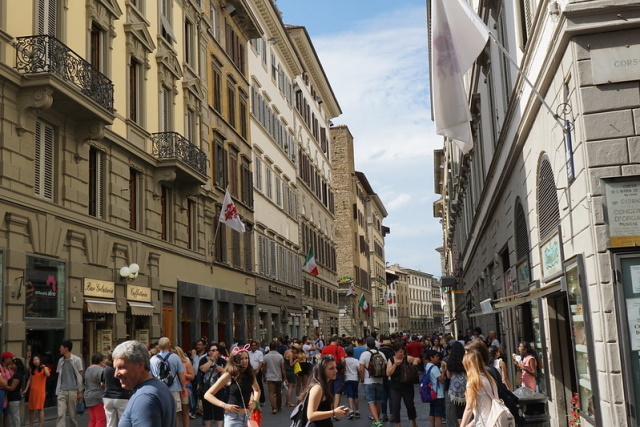
Florence is overrun with tourists, which can make visiting quite unpleasant unless you know where to look. Bologna, on the other hand, is much quieter and nicer to visit most of the time, easier to get a taste of the city’s lifestyle.
While both Bologna and Florence get very hot in the summer, Bologna is a better choice in August as it’s not nearly as crowded. The winters are colder in Bologna, however, often getting fog, snow, and ice for relatively long periods.
While Bologna is a significant industrial and commercial city, it’s quite safe with a strong student town vibe due to the centuries-old university. The city center is very walkable and relatively flat (no hills), with ample sidewalks often covered with porticoes (perfect for visiting on a rainy day).
As mentioned earlier, Bologna is much less tourist-focused than Florence and hence more authentically local – you will typically see more residents than foreign visitors in Bologna. Merchants and hotel/restaurant employees in Bologna are typically friendlier due to lesser tourist crowds.
Some visitors, nevertheless, find Bologna less open to visitors and not so lively for non-students, and choose to stay only one night.
Florence, in contrast to Bologna, is replete with tourists and international expats from all around the world – it’s possible to live in the city without speaking Italian. As a result, Florence is more cosmopolitan, messier, even somewhat pretentious due to its fashion capital status.
Florence can require more work to explore due to the importance and depth of the sights and architecture – visitors need to know what to look for and where in this broad spectrum of sights.
Bologna or Florence: sights & culture
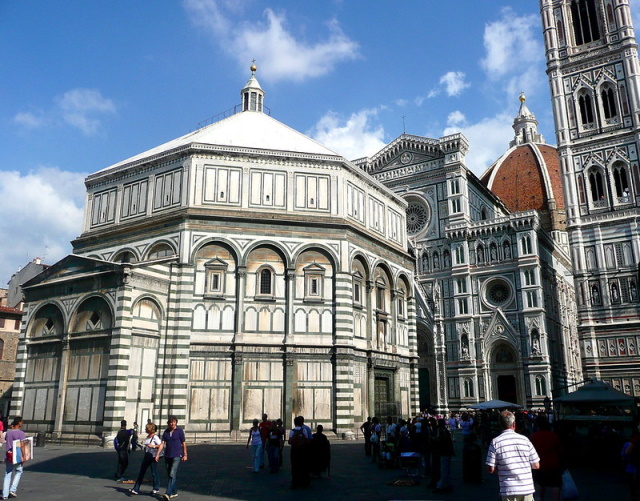
The entire city of Florence is a UNESCO World Heritage Site, with many more museums and galleries than Bologna. Most of these are concentrated in the central city and are within walking distance, but it takes time to see them all.
The Renaissance was born in Florence, bringing Europe out of the Medieval Ages. Artists flocked to the city and endowed it with magnificent Renaissance Art and Architecture.
Key sights in Florence include Michelangelo’s “David” at the Galleria dell’Academia, Botticelli’s “Birth of Venus”, Da Vinci’s “Annunciation” in the Uffizi.
The beautiful Piazza del Signoria square is home to the Palazzo Vecchio (town hall) and the Cellini statue “Perseus with the Head of Medusa”.
The most famous art museums in Florence include the Uffizi, the Bargello, and L’Accademia. Others such San Marco and Ospedale degli Innocente have shorter wait lines. Palazzo Pitti Palace holds famous paintings by Raphael and Titian.
Florence’s Duomo Cathedral and its magnificent tiled dome is a must-see, as is the Ponte Vecchio, a Medieval Bridge lined with jewelers.
The city is blessed with several stunning squares; the most notable are the Piazza Della Republica, the Piazza Santa Maria Novella, the Piazza Beccaria, and the Piazza Della Liberta.
Bologna
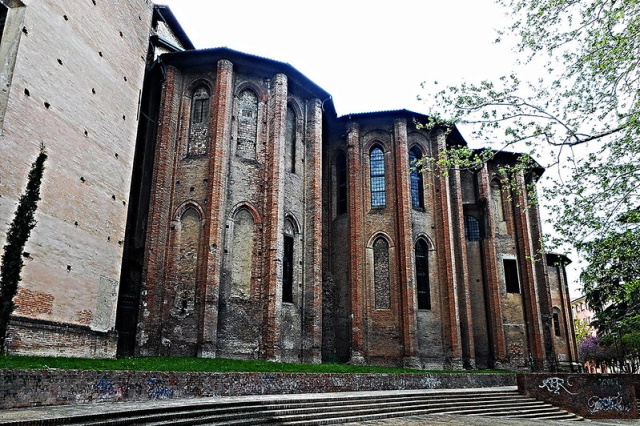
If you don’t like crowds, you can choose to stay in Bologna instead of Florence. It also has some extraordinary art and architecture to explore, just not on the grand scale of Florence.
Bologna’s city center, where you will find all the famous sites, can be explored on foot (helpful Google Map with sights). The city has the oldest University in Europe, and squares, churches, and several museums worth visiting.
Travelers should go to the Museo Civico Medievale, in the Piazza Minghetti, it is housed in a 15th Palace and narrates the turbulent history of the city. The Pinacoteca Nazionale and the Mambo (modern art) museums should not be underestimated.
When walking around the city, be sure to visit the Piazza Maggiore, a Medieval plaza with arched colonnades and Renaissance architecture.
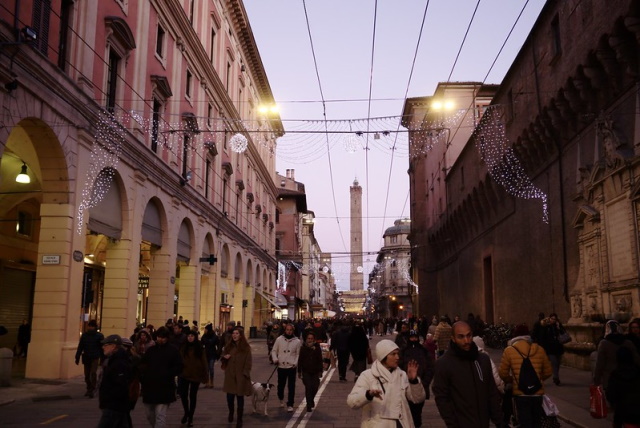
The Palazzo Communal, itself a history of architectural styles, forms one side of the Piazza, and the 11th Century Palazzo del Podestà is on another side.
The 16th Century Fountain of Neptune is nearby. Also see the Stada Maggiore, which was originally built by the Romans and is lined with Medieval buildings
Several of the Medieval Towers of Bologna, called the Torri Pendenti (Asineli and Garisenda), both built in the 12th Century, give Bologna a more Medieval feel than Renaissance.
The Gothic Basilica di San Petronio has an intriguing story into why it is unfinished. Other churches to see include the Basilica San Stefano, Santa Stefano and Fontanna dei Nettuno, as well as a plethora of smaller churches.
Bologna or Florence: food & nightlife
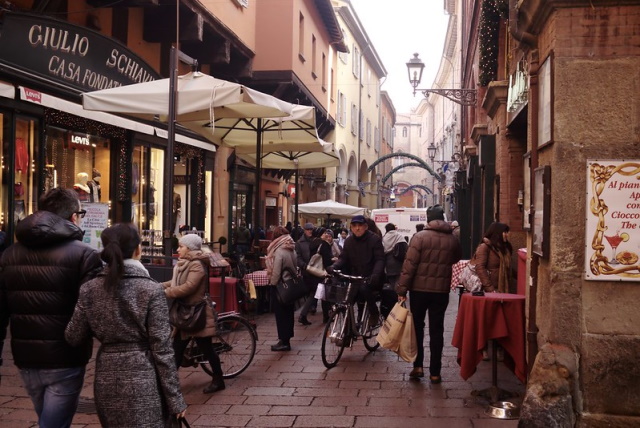
Every place in Italy has its famous regional cuisine and Bologna and Florence are no exception. In Bologna is the prosciutto, balsamic and parmiggian regianno. Florence has its pecorino and bistecca.
Bologna’s medieval market district, Quadrilatero, is where you will find artisan produce like mortadella, cheeses, freshly prepared pasta, especially tortellini.
Spend a morning buying amazing food and have lunch and a glass of wine with the local market vendors at the 15th Century Osteria del Sole. Or try the grilled mortadella with balsamic vinegar at Da Gianni while at the market.
Bologna’s famous pasta sauce, the ragu alla Bolognese is widely available. Chef Emilia Romagna is a huge draw, and people often come to the city just for one of his meals.
The All’Osteria Bottega is a good place to try exemplary local cuisine. The Gampi e Ciccio is also a classic Bologna restaurant full of charm
Florence has even more quality restaurants, including one of Europe’s most famous restaurants, recommended by the Michelin Guide; the Enoteca Pinchiorri.
The food market in Florence, the Mercato Centrale is generally considered more interesting than Bologna’s various food markets.
Florence also has a very lively nightlife, a little on the decadent side, so be warned. Bologna’s nightlife, on the other hand, is more laid back.
Bologna or Florence: shopping
Bologna is a market town and trade center with many upmarket shopping streets filled with artisanal and boutique shops selling luxury items from smaller exclusive brands. The city is generally not the best place to shop for well-know luxury brands.
Florence is a fashion capital; full of haute couture fashion boutiques, making it a great place to buy a unique leather handbag or jacket. It is also world-famous for its handmade shoes.
Bologna or Florence: lodging
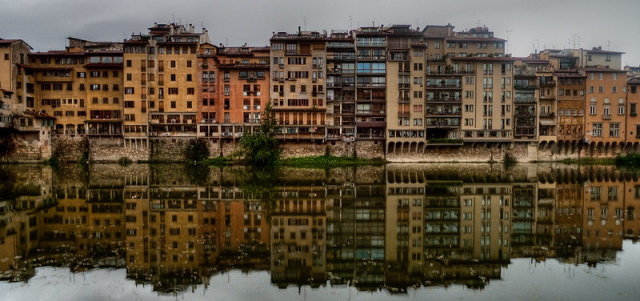
In Bologna in the summer, travelers should generally make lodging reservations early as it can often be fully booked.
Keep in mind that one of the most important beauty and cosmetic fairs worldwide, Cosmoprof, takes place in Bologna at the end of April. During this time, hotel prices skyrocket, sometimes to more than double the normal prices. Some hotels sell out one year in advance.
Places in the city center are convenient for getting to the airport and to the train station, with an abundance of taxis. As is often the case, the area immediately around the train station isn’t attractive.
Travelers find that the Hotel Metropolitan, halfway between Piazza Maggiore and the Central station, is well worth the price, especially in the very hot summer months.
Hotel Porta San Mamolo gets a lot of praise for its beautiful facilities and its great location.
Casa Bertagni is a small B&B conveniently located near the university, with an energetic and eclectic atmosphere.
The neighborhood of Santa Stefano is full of great places to stay and eat. The Antica Casa Zucchini B&B is often vetted by travelers, being close to the beautiful Giardino Regina Margherita Park. it’s a relatively long walk to the train station and to the city center, however.
If you plan to use Bologna as a base for day trips, travelers often praise the Albergo delle Drapperie B&B – just be aware it’s a bit noisy due to its proximity to the train station.
Florence
In Florence, the city center is the best option to stay for a short trip. It gives you the opportunity to see many of the sights in a short walk and go back to your hotel often.
The 3-star Hotel Hermitage with its wonderful breakfast terrace is well-priced and caters to English-speaking guests. It has a great location right next to the Ponte Vecchio.
Travelers also recommend Hotel Tornobuoni Beacci and Hotel Torre Guelfa, two nice options right in the center of town with pleasant rooftop bars.
Also recommended is Hotel Spadai, next door to the Duomo, and Hotel California, a block away towards the Academia. Hotel la Scaletta is also a good choice, with great breakfasts and a rooftop view over the Duomo.
Travelers also praise Hotel Paris and Hotel Bigallo – the latter is on a very quiet side street just around the corner from the Baptistry.
If you need to be close to the train station, the lovely little Hotel Casci is close to it and also to many of the sites.
More upscale, Hotel Davanzati is highly recommended. Be aware there is a flight of stairs up to the lobby.
Bologna or Florence: day trips

Bologna is a central city perfect for day trips either by train or car. Close by are the attractive towns of Modena, Mantua, Verona, Vicenza, Parma, Ferrara, Mantova, Ravenna, Mantova and Orvieto, all generally much less crowded than Florence or Siena.
Ferrara has an amazing castle and a lovely city center. Parma is a very historic city with great sights. Orvieto is a beautiful little town perched on a cliff in rolling countryside.
Ravenna has mosaics dating back to the early years of Christianity in its ancient churches and mausoleums. In the summer, Ravenna is a beach destination, so making early train bookings and avoid weekends if possible.
From Florence, Tuscany is at your doorstep, with its beautiful towns near enough to visit in a day. Pisa, for the Leaning Tower, is very close. The towns of Alto, Cortona, Arezzo, Certaldo, Montecatini Terme and Siena are well worth a visit.
Fiesole with its history, hiking, monastery and wonderful views is reached via a scenic bus journey.
***
Photo credits:
(1) Featured: “Florence” (CC BY 2.0) by BPPrice
(2) “Bologna” (CC BY 2.0) by liakada-web
(3) “Florence” (Public Domain) by thinkrorbot
(4) “Florence” (CC BY 2.0) by HerryLawford
(5) “Gothic apses 14th century – San Domenico” (Public Domain) by Carlo Raso
(6) “Bologna” (Public Domain) by boklm
(7) “Bologna” (Public Domain) by boklm
(8) “Florence” (CC BY 2.0) by dameetch
(9) “1633-Ravena” (CC BY 2.0) by xiquinhosilva

